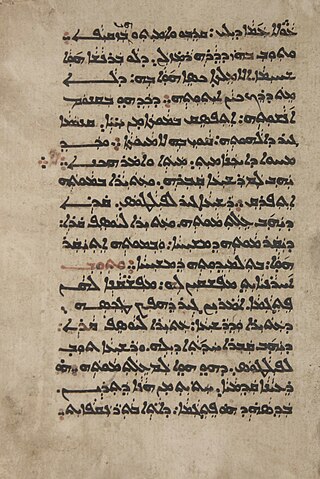Gregory Bar Hebraeus, known by his Syriac ancestral surname as Barebraya or Barebroyo, in Arabic sources by his kunya Abu'l-Faraj, and his Latinized name Abulpharagius in the Latin West, was a Maphrian of the Syriac Orthodox Church from 1264 to 1286. He was a prominent writer, who created various works in the fields of Christian theology, philosophy, history, linguistics, and poetry. For his contributions to the development of Syriac literature, has been praised as one of the most learned and versatile writers among Syriac Orthodox Christians.
Dionysius bar Salibi was Syriac Orthodox writer and bishop, who served as metropolitan of Amid, in Upper Mesopotamia, from 1166 to 1171. He was one of the most prominent and prolific writers within the Syriac Orthodox Church during the twelfth century.

Isaac the Syrian, also remembered as Saint Isaac the Syrian, Isaac of Nineveh, Abba Isaac, Isaac Syrus and Isaac of Qatar, was a 7th-century Syriac Christian bishop and theologian best remembered for his written works on Christian asceticism. He is regarded as a saint in the Church of the East and in the Eastern Catholic, Oriental Orthodox and Eastern Orthodox traditions. His feast day falls, together with 4th-century theologian and hymnographer St. Ephrem the Syrian, on January 28.
Saint Michael the Syrian ,(Classical Syriac: ܡܺܝܟ݂ܳܐܝܶܠ ܣܽܘܪܝܳܝܳܐ, romanized: Mīkhoʾēl Sūryoyo), died 1199 AD, also known as Michael the Great or Michael Syrus or Michael the Elder, to distinguish him from his nephew, was a patriarch and saint of the Syriac Orthodox Church from 1166 to 1199. He is best known today as the author of the largest medieval Chronicle, which he wrote in the Syriac language. Some other works and fragments written by him have also survived.
Ignatius Niʿmatallah was the Patriarch of Antioch and head of the Syriac Orthodox Church from 1557 until his resignation in 1576.
Ignatius Noah of Lebanon, also known as Nūḥ Pūnīqoyo or Nūḥ al-Bqūfānī, was the Patriarch of Antioch and head of the Syriac Orthodox Church from 1493/1494 until his death in 1509.
Andreas Masius was a Catholic priest, humanist and one of the first European syriacists.
The Council of Capharthutha was a synod of the Syriac Orthodox Church held in February 869 AD under Patriarch John IV of Antioch. It was called to resolve the differences between the Patriarch of Antioch and the Maphrian of the East over their ecclesiastical jurisdiction in Mesopotamia and Persia. It aimed to regulate mutual relations and to resolve some difficulties that were frequently arising between two centers.
Athanasius IV Salhoyo was the Patriarch of Antioch and head of the Syriac Orthodox Church from 986/987 until his death in 1002/1003.
Theodosius Romanus was the Patriarch of Antioch and head of the Syriac Orthodox Church from 887 until his death in 896.
Dionysius II was the Patriarch of Antioch and head of the Syriac Orthodox Church from 896/897 until his death in 908/909.
Elijah, Eliya, or Elias of Nisibis was an Assyrian cleric of the Church of the East, who served as bishop of Beth Nuhadra (1002–1008) and archbishop of Nisibis (1008–1046). He has been called the most important Christian writer in Arabic—or even throughout non-Christian Asia—during the 11th century. He is best known for his Chronography, which is an important source for the history of Sassanid Persia.
Simeon of Beth Arsham was a Syrian bishop who spread his teachings at the beginning of the sixth century. He was the bishop of Beth Arsham, which was located near Seleucia-Ctesiphon.
Masʿūd Zazoyo or Masʿūd of Zaz was a Syriac Orthodox author, hermit, monk and prelate.
Mosesof Nisibis was a West Syriac monk and scribe. He was the abbot of Dayr al-Suryan, the Syrian monastery in the Wadi al-Natrun in Egypt, from 914 at the latest. He brought together and helped preserve one of the most important collections of ancient Syriac manuscripts, which is still of critical importance to scholars today.
George was the Syriac Orthodox bishop of the Arabs around Aleppo and the upper Euphrates from 686 or 687 until his death. A polymath steeped in ancient Greek philosophy, his writings are an important source for Syriac history and theology.
Simeon of Rev Ardashir, whose name in Syriac is Shemʿon, was a Persian priest and jurist of the Church of the East. He served as the metropolitan bishop of Fars with his seat at Rev Ardashir. His dates are uncertain, as is his identification with the metropolitan of the same name known from a pair of letters.
Gabriel of Qatar, also known as Gabriel Qaṭraya bar Lipeh, was a Qatari Syriac writer of the Church of the East. He wrote a commentary on the East Syrian liturgy.
John, in Syriac Iwannis, was a Syriac Orthodox writer and the metropolitan bishop of Dara (Anastasiopolis). He wrote extensively on theology, philosophy and liturgy in the Syriac language.

Yoḥannan bar Zoʿbi, commonly Rabban Yoḥannan and sometimes anglicized John bar Zobi, was a monk, grammarian, philosopher, theologian and liturgist of the Church of the East who wrote in Syriac.

